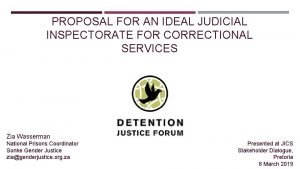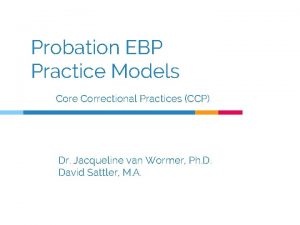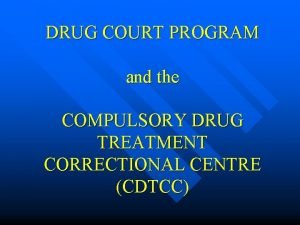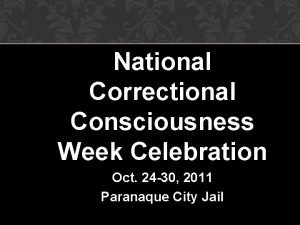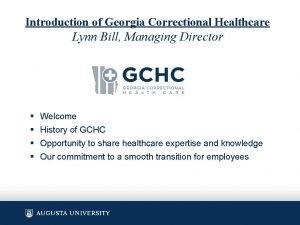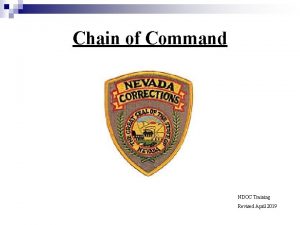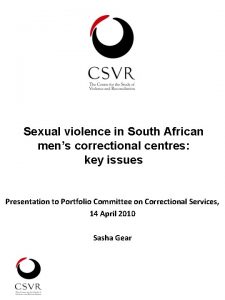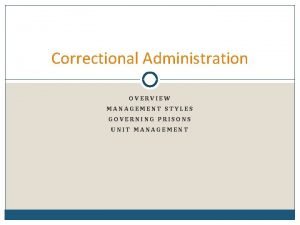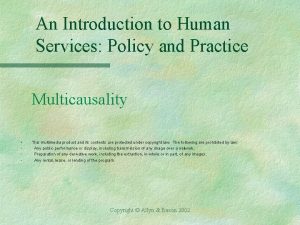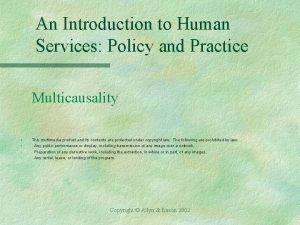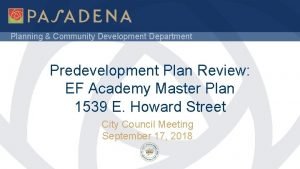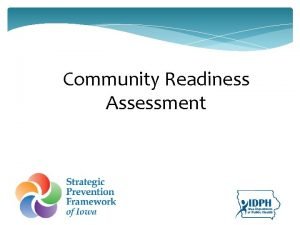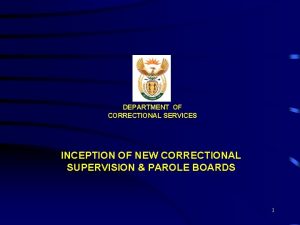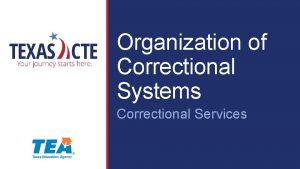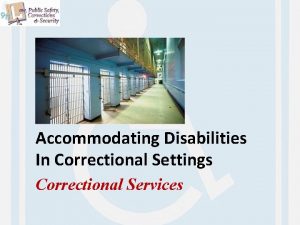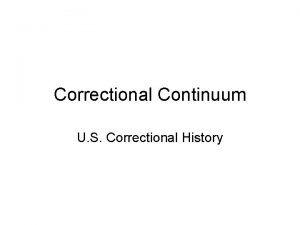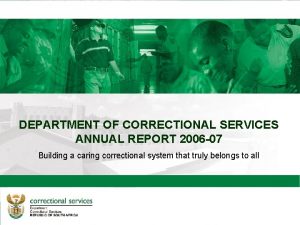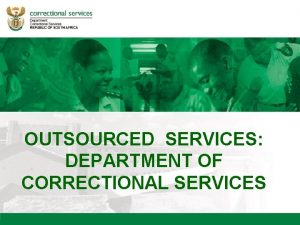DEPARTMENT OF CORRECTIONAL SERVICES STRATEGIC PLANNING SESSION POLICY


















































- Slides: 50

DEPARTMENT OF CORRECTIONAL SERVICES STRATEGIC PLANNING SESSION POLICY DEVELOPMENT AND RESEARCH THE STATE OF POLICING IN SOUTH AFRICA August 2019 CIVILIAN SECRETARIAT FOR POLICE 1

PURPOSE OF THE PRESENTATION • To inform DCS on the state of policing in South Africa & the implications of the state of policing on DCS • To discuss changing the way we do our work to address crime & violence and lessen the burden on the JCPS cluster departments CIVILIAN SECRETARIAT FOR POLICE 2

LEGAL FRAMEWORK • The Civilian Secretariat for Police Service (CSPS) is a constitutional body that serves to ensure the transformation of the SAPS by promoting accountability and transparency in the police service. • The CSPS exercises civilian oversight over the police service, in line with the mandate outlined in Sections 2 and 3 of the SAPS Act. • The CSPS is established in terms of Civilian Secretariat for Police Service Act, (Act no 2 of 2011) 3 CIVILIAN SECRETARIAT FOR POLICE

OBJECTS OF THE CSPS • Exercise civilian oversight over the Police Service through monitoring and evaluating overall police performance against planned programmes; • Give strategic policy advice to the Minister in respect of developing and implementing policies and draft legislation • Implement a partnership strategy to mobilise role-players and stakeholders to strengthen service delivery by the police service to ensure the safety and security of communities; 4 CIVILIAN SECRETARIAT FOR POLICE

SOME FACTS • The burden of the JCPS cluster is tremendous • Budget of the JCPS cluster is approx. R 206 billion p. a. because crime & violence is so high and the JCPS cluster departments need to deal with the high crime & violence • Most of the ‘drivers’ of crime (socio economic factors including poverty, inequality, unemployment, social welfare, health and education) rests with other government departments 5 CIVILIAN SECRETARIAT FOR POLICE

SOME NUMBERS • SAPS = 193 000 • PRIVATE SECURITY = 500 000 • SOCIAL WORKERS = 19 000 SOMETHINGS NOT RIGHT HERE!! 6 CIVILIAN SECRETARIAT FOR POLICE

STATE OF POLICING IN SOUTH AFRICA CIVILIAN SECRETARIAT FOR POLICE 7

INTRODUCTION AND BACKGROUND q Aim of study: To assess the state of ‘democratic policing’ in South Africa q Defining democratic policing: democratic policing means that the police uphold the rule of law, are accountable and act in a manner that is procedurally fair and in service of the public CIVILIAN SECRETARIAT FOR POLICE 8

METHODOLOGY AND FRAMEWORK OF RESEARCH q Framework of analysis explored 9 Dimensions of democratic policing: (1) Knowledge: equipped with skills (2)Trust: public perception of the police (3) Empathy: respectful interface with the public (4) Ethics and accountability: adherence to the applicable laws (5) Objectivity: fair treatment to all (6) Rights-based policing: Policing within the limits of the law, adheres to human rights and related protections, and promotes the values of transparency, fairness, equality and justice CIVILIAN SECRETARIAT FOR POLICE 9

METHODOLOGY AND FRAMEWORK OF RESEARCH (7) Police as citizens: police’s rights are protected (8) Efficiency and effectiveness: Police effectiveness: what and how much police have accomplished in the eyes of the public Efficiency: cost-effective and timeous utilisation of resources (9) Responsivity: Sensitive to victims of crime and community orientation CIVILIAN SECRETARIAT FOR POLICE 10

9 DIMENSIONS OF A POLICE Input variables Outcome Result Knowledge Objectivity Trust Legitimacy Effectiveness & efficiency Responsivity Ethics & accountability Empathy Rights-based Police as citizens CIVILIAN SECRETARIAT FOR POLICE 11

FINDINGS OF THE STUDY AGAINST THE 9 DIMENSIONS OF DEMOCRATIC POLICING CIVILIAN SECRETARIAT FOR POLICE 12

KNOWLEDGE q How is professionalism understood? • UK Independent Commission & 2016 White Paper on Policing definition of professionalism: demanding standards; selfregulation: ensuring institutional autonomy and less bureaucratic control; expertise; internalized norms. • SAPS understanding of professionalism is of a top-down approach to enforce compliance with policy and procedure • SAPS Training: abolished rank promotion exams. CIVILIAN SECRETARIAT FOR POLICE

KNOWLEDGE • • • What prevents/limits application of knowledge for Democratic Policing (DP)? Rhetoric by leadership; treatment of external advice and criticism; The strategic objectives are not supportive of DP (e. g. trust, empathy and police as citizens do not feature in Strat Plan). Indicators are frequently flawed – either misplaced, selffulfilling or focused on inputs and not outcomes. CIVILIAN SECRETARIAT FOR POLICE

KNOWLEDGE q What are the consequences of knowledge gaps • Unlawful arrests and detention: 1. 6 million people arrested 18. 7% convictions (average). This is relevant to DCS • Data indicates a massive attrition rate from arrest to conviction amounting to more than 80% • Only 8% are incarcerated, rest have a non-custodial sentence (suspended sentence, fines) • This implies that a large number of people arrested unnecessarily: • because there was no case to start off with, or • other means should have and could have been used to ensure their attendance at court CIVILIAN SECRETARIAT FOR POLICE

KNOWLEDGE • Attrition may be due to NPA’s selection criteria for prosecuting cases and partly by the quality of cases received from the police • NPA has a 93% conviction rate, an important factor will thus be how likely a conviction will be when selecting cases for prosecution CIVILIAN SECRETARIAT FOR POLICE

KNOWLEDGE q Recommendations • Adopt a learning organisation: SAPS needs to be open to critique, admits mistakes and take concrete steps to learn from mistakes and successes – a reflective organisation. • Establish a professional body as per the National Policing Board. • Assess the impact of SAPS pre-recruitment training. CIVILIAN SECRETARIAT FOR POLICE

ETHICS AND ACCOUNTABILITY q Do officials perceive that they will be held accountable? q Integrity: • Code of silence - 26% will not report receiving free meals & gifts and believe that 46% of colleagues will also not report it. • Complaints against police (IPID) – increased from 5880 in 2014/15 to 7014 in 2016/17. CIVILIAN SECRETARIAT FOR POLICE

ETHICS AND ACCOUNTABILITY • Civil claims – Significant reduction in claims made and paid out in 2016/17. Average of R 681 million p. a. of which R 189 million paid out p. a. on average, yet not recouped as required by Treasury Regulations. The Public Audit Amendment Bill will assist AG to recoup state losses. Claimed Paid 1200000 1023230. 252 947918. 429 1000000 1009259. 757 821956. 281 800000 715172. 268 606705. 251 641475. 522 600000 531003. 764 400000 295523. 457 200000 131437. 122 171683. 687 190819. 549 253991. 3 268530. 285 275682. 527 218578. 819 180229. 671 173805. 172 173814. 416 71440. 258 0 2007/8 2008/9 Civil claims lodged and paid 2009/10 2010/11 2011/12 2012/13 2013/14 CIVILIAN SECRETARIAT FOR POLICE 2014/15 2015/16 2016/17 19

ETHICS AND ACCOUNTABILITY q. Disciplinary code: few are disciplined <5000 p. a. nearly 50% withdrawn /acquitted. Approximately 50% of disciplinary actions in SAPS result in acquittal or withdrawal compared to 5. 4% at DCS. On average 2. 5% of staff in SAPS are subject to disciplinary action compared to nearly 10% in DCS. • Light disciplinary sanctions: e. g. 2/3 rds received written or verbal warning for Assault GBV 2014/15. Victims of Crime Survey: nationally 14% of households reported being asked for bribe e. g. Gauteng 22%. q. Code of conduct: few are trained <5000 p. a. No evidence of refresher training and dealing with practical situations. Ideals of the Code are drowned out by the sub-culture. CIVILIAN SECRETARIAT FOR POLICE 20

ETHICS AND ACCOUNTABILITY q. Officials do not ‘feel accountability’: AGSA very critical of SMS: same issues raised for a number of years and not resolved. E. g. Crime intelligence & Marikana. q Obstacles to accountability: low disciplinary rate; light sanctions; civil claims; IPID capacity; relationship with NPA. q Overall impression: accountability value chain is broken; law is good but not enforced or inconsistently enforced. CIVILIAN SECRETARIAT FOR POLICE 21

ETHICS AND ACCOUNTABILITY q Recommendations • It is critical that individuals are held accountable against a known and understandable standard. • Sanctions must reflect the severity of the crime. • Need to strengthen training to prevent as far as possible misuse of authority. Includes continued refresher training. • The relationship between SAPS and IPID as well as with NPA needs to improve in order to make accountability real. CIVILIAN SECRETARIAT FOR POLICE

EFFICIENCY AND EFFECTIVENESS SUFFICIENT RESOURCES? q Sufficient resources to be effective • 194 000 personnel and 51 000 vehicles, spending over R 1500 per capita. • Better police per 100 000 ratio than Africa and world (354 per 100 000) q BUT 96% of police stations are “understaffed” on SAPS theoretical • Too many deployed at Management and ‘Divisions’: • Geographical distribution among police stations has problems • Structuring within police stations has problems: Category, A, B, C 1 or C 2 CIVILIAN SECRETARIAT FOR POLICE

EFFICIENCY AND EFFECTIVENESS PROBLEMS WITH RESOURCE FORMULA q Formula problems: arbitrary choice and weighting of the factors taken into account, double counting of factors, etc. q Key problems 1. Reliance on reported crimes: Poorly resourced stations will show poorer reporting: reinforcing the cycle. 2. Failure to weight murder sufficiently • Only weighted 2. 5 times other crimes, equal to other contact crimes. • Murder is the only “trusted” figure and must be taken far more seriously. CIVILIAN SECRETARIAT FOR POLICE

EFFICIENCY AND EFFECTIVENESS PERFORMANCE MEASURES q Performance measures • Reliance on reported crime fails to recognise that reported crime will go up with greater trust in police. • Over-reliance on SAPS-recorded information (e. g. reaction times are provided by SAPS officials themselves) with the potential risk of information tailored to improve an indicator. • Time-bound indicators encourage delay (e. g. % of firearm license applications finalised within 90 days’ may encourage delay up to 89 days). Therefore use norms to guide officials. • Performance indicators: very much at micro-operational level and not facilitating the Democratic Policing (i. e. indicators implying automatic communities’ trust). Objective statements (e. g. Transform and professionalise the Service) misaligned to indicators (e. g. % of IPID disciplinary cases finalised). CIVILIAN SECRETARIAT FOR POLICE

EFFICIENCY AND EFFECTIVENESS PERFORMANCE MEASURES (cont. ) • Targets are modest, given the size of the organisation. None of SAPS indicators pay attention to public experience, they are complex and difficult for the lay person to understand. • Failure to recognise perverse incentives and interlinkages of programmes e. g. crime prevention is not just a Visible Policing matter but cut across Crime Intelligence and Detective Services. q Recommendations on crafting indicators: • (1) Reduce criminal victimization. (2) Call offenders to account. (3) Reduce fear and enhancing personal security. (4) Guarantee safety in public spaces (incl traffic safety). (5) Use financial resources fairly, efficiently and effectively. (6) Use force and authority fairly, efficiently and effectively. (7) Satisfying customer demands/achieving legitimacy with those policed. CIVILIAN SECRETARIAT FOR POLICE 26

EFFICIENCY AND EFFECTIVENESS CONT. RESOURCING RECOMMENDATIONS q Indicators: (i) Review all indicators for perverse incentives; and use changes in trust and the murder rate as primary indicator of performance. (ii) Evaluate whether the collection of the large range of indicators is itself consuming disproportionate resources. (iii) Crime reports should be seen as a tool of analysis rather than as performance measures. q Investigate deterioration in effectiveness and efficiency since 2012: • Re-evaluate the primary, geographical and police station distribution of resources, in particular, arrive at an appropriate model of policing for high murder rate areas. This should include a far higher investment in intelligence-led Visible Policing. q South Africa cannot afford the billions of additional funding the analysis suggests is required to increase safety with the current structure and functioning of SAPS. Gains in safety can be made without additional cost through improved training, reduced levels of bureaucracy and flattening the hierarchical structure, lower level of administration, devolved decision making. CIVILIAN SECRETARIAT FOR POLICE

POLICE AS CITIZENS q Recruitment practices - Community based recruitment is problematic (e. g. manipulation at community level, placement issues). Promotion and pay: SAPS employees are well-paid; Rank promotion without examination is highly problematic. Further research is required to assess rigor of the assessments to determine competence. q Employee Health and Wellness - Looks good on paper but overall impression is that the impact is limited; confidentiality of consultations; Lifestyle issues (e. g. hyper tension, obesity, substance abuse). q How dangerous is police work? Deaths on & off duty have declined rapidly since 1994 (265 to 83 p. a. ) but it is unclear why. • Majority die due to accidents and murder off duty (suicide rate in SAPS 5 times that of the national rate); Driving skills and not wearing seat belts). CIVILIAN SECRETARIAT FOR POLICE

POLICE AS CITIZENS q Discipline management – Disciplinary code does not link offense to sanction, rather introduces new categories of offenses. q Recommendations • The EHW programme needs to be strengthened to deal with risks proactively esp. suicide and life style choices. Compulsory debriefing. Review the community recruitment programme; and upgrade driving skills and enforce wearing of seat belts. CIVILIAN SECRETARIAT FOR POLICE 29

HUMAN RIGHTS BASED DIMENSION q Concern about the SAPS conduct • Out of 18 412 complaints to IPID against SAPS, 75% of complaints were of a human rights nature. • Between 2014 and 2016: 21% increase in complaints (4 132 – 4 506). • Civil claims for unlawful arrest increased sharply from 2010/11. R 222 mil paid for unlawful shootings over 8 years period, a financial burden on tax payers. R 982 mil paid in civil claims for wrongful arrests and detention. • Legal and policy framework is sufficient (White Paper on Policing, NDP and Code of Conduct) BUT officials and managers are not held accountable; training is lacking CIVILIAN SECRETARIAT FOR POLICE 30

HUMAN RIGHT BASED DIMENSION CONT. q Optional Protocol to the Convention against Torture and other Cruel, Inhumane and Degrading Treatment (OPCAT): • Not ratified which means police detention is without regular independent monitoring (consequence: lack of reliable data on the use and conditions of detentions). q Human rights in the training curriculum? • The copy of the training curriculum was insufficient. • Unclear but the overall impression is that it has limited impact on operational level. Too few officials (approx. 13 000 of 102 000 officials in VISPOL). Very limited refresher training • Human Rights are covered during Induction Courses • Human Rights Learning Programme – duration – 5 days. For the past three years 1 864 (1%) of SAPS officials attended. CIVILIAN SECRETARIAT FOR POLICE 31

HUMAN RIGHT BASED DIMENSION CONT. • Other HR aligned courses were provided in 2015/16 to 17 241 Vis. Pol officials in 2015/16, namely Children’s Act, Domestic Violence Act and Child Justice Act; Children and Youth at Risk, HR in Policing, etc. In 2016/17, there were no HR training indicated (Annul Reports) • Therefore Rights violations and limited training on HR reflect SAPS as not fully committed to advancing Human Rights. q Recommendations • Improve training on ethics and accountability for violation of human rights • Improve training on use of force and arrests without a warrant • OPCAT ratification CIVILIAN SECRETARIAT FOR POLICE 32

EMPATHY q Special attention to victims of violence and sexual violence? • Victims’ Charter, FCS Units, SOP and Nat Instr. Some measures to improve empathy in Victim Empowerment Manual and in NI on Sexual Violence; training = done in past 3 years. • The ratio of FCS units relative to the number of police stations in provinces was unsatisfactory. This ranged from 5. 1 stations per FCS unit in North West to 7. 6 stations per FCS unit in the Northern Cape. • 2017 MRC report noted massive attrition in rape cases in Criminal Justice System stress levels of officials; vehicle shortage; Many Inv Officers hold conservative views regarding rape and subscribe to rape myths; half of rape cases led by constables (jnr. rank); poor supervision of investigations; basic admin often not correct; poor docket management; shortage of rape kits; evidence not collected (13%) or collected and not sent through (21%). • Six point plan adopted to remove barriers to reporting sexual crimes. CIVILIAN SECRETARIAT FOR POLICE 33

EMPATHY CONT. q Measures to improve empathy skills? • 3 requirements for Victim-friendly service (e. g. infrastructure, training of officials, no measurement of good service. • MRC report indicate that sensitivity and empathy skills training is not sufficient. There is no specific training for detectives on empathy skills; same applies to witnesses. q Recommendations • Need to conduct victim satisfaction surveys on continuous basis; • Training on specifically empathy skills; rape myths and gender attitudes. Especially for detectives and frontline staff • Measure progress on 6 -point plan implementation CIVILIAN SECRETARIAT FOR POLICE 34

OBJECTIVITY q Are the police objective? • Growing % of respondents believe that people receive unequal treatment under the law (44% - 2002, 64% - 2015); 70% believed officials break the law & go unpunished (Afrobarometer). • Arrest trends: large numbers arrested: 1. 6 million; roughly half = for crimes (drugs, crimen injuria, less serious crimes). Mostly poor men aged 18 & 65 years (1/8 and 1/13): arrested annually (2011/12), very similar numbers to era of pass laws, if adjusted. • 54% of cases in pre-trial detention were withdrawn or struck from the roll (DBN, JHB and Mitchells’ Plain: 2008), meaning a substantial number of arrests were either unnecessary or poorly investigated or potentially unlawful. • Race and gender in pre-trial pop. : 32% coloured females = awaiting trial versus 18% white females. CIVILIAN SECRETARIAT FOR POLICE

OBJECTIVITY CONT. • Road blocks (32 000: 2017); Stop and Search (S&S) - 3. 2 million: used extensively and shape public’s trust in the police. Twelve (12) S&S = 1 arrest; each roadblock results in 0. 5 arrests. • Hate crimes: No legislation yet. Hate Crimes Working Group (HCWG) – raised very concerning findings about why victims of hate crimes don’t want to report crimes to SAPS (e. g. re-victimisation), leading to two thirds of victims of hate crime not reporting crime to the police. • Refugees and immigrants: 71% reported being stopped by police compared to national rate of less than 30%. Number of illegal immigrants arrested dropped from 80 000 in 2005 to 25000 by 2015. Procedure has also been improved for detention i. e. designated stations, 30 day limit. Draft Standing orders being developed. CIVILIAN SECRETARIAT FOR POLICE 36

OBJECTIVITY CONT. • LGBTI: Safe custody is deep concern when arrested. And speaks to a broader issue of detention management in general that is poor. • Sex workers: Arrest figures have come down after SWEAT case in CPT (2009) but reports of arrest and harassment persist. q What measures are in place? • Very limited training on arrests without a warrant, few officials are trained, refresher training? No disaggregated arrest data (e. g. race, gender). q Recommendations • Continuous Training and Sensitization; • Research on arrest and S&S to establish extent of bias and its consequences. CIVILIAN SECRETARIAT FOR POLICE

RESPONSIVITY q How is responsivity measured? • Measurement to assess police performance e. g. response time, nr of arrests, use of force etc. But good policing is broader in scope than what these performance measures indicate, it is important to consider an officer’s response to citizens’ needs during the course of their interactions. • Responsivity requires a policing approach that addresses community needs and concerns (community-centred) and victims of crime (victim-centred), which is crucial in building public confidence and ultimately trust in the police. CIVILIAN SECRETARIAT FOR POLICE

RESPONSIVITY q Are measures in place to improve responsivity? • Complaints response – target: 70% of complaints ‘finalised’ in 30 working days. In 2016/17 89. 2% BUT what does ‘finalised’ mean? There is no feedback on client satisfaction. • Frontline Service Delivery Monitoring programme have made unfavorable findings about SAPS services, esp complaints management. Challenges to be addressed through the Service Delivery Improvement Plan. • Sector policing aimed at improving community interaction - facing resource issues and lack of inbuilt impact assessment tools in the Implementation Guideline. • CPF’s - 99% of stations have CPFs but with problems wrt functionality and effectiveness. q How are citizens’ complaints dealt with? - SO 101 sets out procedure; and SAPS Customer Satisfaction Survey, 2016/17 - between 53% and 58% rated their experience with SAPS as ‘Below average’ and ‘Poor’. CIVILIAN SECRETARIAT FOR POLICE 39

RESPONSIVITY CONT. • Commission on Gender Equality assessed SAPS performance against Victim’s Charter in 2009 and 2012 - concerned about SAPS’ handling of complaints. • Victim of Crime Survey - Victim satisfaction in general decline since 2011. Dissatisfied households: majority (59%) felt that SAPS never recover their goods; 15% complained that SAPS doesn’t respond on time. • Repeat Victimisation Index - on the increase which implies that police is not doing enough to protect these households. • Western Cape Police Ombudsman and Do. CS – There are interesting developments and should be looked at. • SAPS: developing a database for oversight agencies’ recommendations = Important step in the right direction. q Recommendations • Conduct Client Satisfaction Surveys continuously; Engage external stakeholders continuously; Conduct thorough evaluation of CPFs. Adopt a broader understanding of responsivity – need for qualitative measurements. CIVILIAN SECRETARIAT FOR POLICE

TRUST Percent who trust the police “somewhat” or “a lot” • The best measure of whether the police are democratic must be determined by whether or not the public trusts the police. “Trust” should be the outcome if all other components of democratic policing are achieved. • Levels of trust have improved from 2005 to 2015 by 10% points. Trust in the police is low: 60% 50% 40% 35% 36% 41% 48% 42% 49% 45% 20% 10% 0% 2000 2002 2004 2006 2008 CIVILIAN SECRETARIAT FOR POLICE 2011 2015 Trust in police 41

TRUST 75% SABC 70% Army 62% SARS 58% IEC 2015 2011 2008 2006 2004 2002 58% Public Protector 57% Courts 56% Hawks 55% NPA 45% Police 44% Traditional leaders 0% 50% • The police remain the leasttrusted of the four security institutions • SAPS’s overall figure of 45% is lower than the 55% average level of trust in police for the 34 Afrobarometer countries surveyed. 100% CIVILIAN SECRETARIAT FOR POLICE 42

DRIVERS OF TRUST q Difficulty to access the police influences trust negatively. q Perception that influence trust in the police: • Ordinary people who commit crimes go unpunished & Officials who commit crimes go unpunished (stronger effect). • People are treated unequally under law on race and ethnic basis. • Corruption of police; and feelings of lack of personal safety. q Serurubele Survey: Victimisation - 27% (respondents who were victims of crime in the last 3 years = “no confidence” in SAPS compared to 21% in the total population. • Exposure to criminal court and contact with police especially victims – negatively associated with confidence in the police. • Demographic variables - Income and tertiary education = strong negative correlation with confidence in the criminal justice system, correlation even more stronger than victimisation. CIVILIAN SECRETARIAT FOR POLICE 43

TRUST RECOMMENDATIONS ON TRUST q Conclusions • SAPS - improved trust up to 2011 but subsequent deterioration. Thus, SAPS = capable of making improvements in trust through improvements in all police operations. • Performance in the last 7 years has not built trust. • Corruption, unequal treatment, difficulty in accessing SAPS drive lack of trust. • SAPS does not prioritise trust. q Recommendations - SAPS should: q Make an independently measured indicator of trust the primary performance measure. • Seek methods of easing the experience of requesting assistance: – Prioritise resources for public interface. – Improve the experience of reporting crime. • Ensure that actual/ perceived unequal treatment does not occur on either a person or geographic basis. The evidence suggests the latter is currently the case. • Decisively deal with corruption. CIVILIAN SECRETARIAT FOR POLICE

RECOMMENDATIONS FOR SAPS • • Measure what matters (e. g. measure trust) Distribute resources where they are needed Training to be able to do the job A stable visionary and strategy-wise leadership (to turn SAPS around requires long term strategy that is sustained) • Accountability and transparency • Policy is not practice • Mistakes should be learnt from (feedback loop from management. CIVILIAN SECRETARIAT FOR POLICE

IMPLICATIONS FOR DCS • WPP/NDP is requesting SAPS be professionalised (improving investigations…) • Revitalising of DPCI & NPA (more investigators…) a) Increased arrests and prosecutions of violent offenders, those falling under the Minimum Sentencing Act, will undermine DCS ability to accommodate short sentenced offenders b) Prosecution of non-violent offenders receiving lengthy sentences for corruption will mean DCS will require more facilities. These offenders will have to be accommodated separately from non- violent offenders CIVILIAN SECRETARIAT FOR POLICE

CONCLUSION • The current economic climate has seen a resurgence of crimes – likely resulting in uptake of convictions • Budget cuts will impact this • If crime & violence is addressed, there will be no need for the huge budget • Safety is a ‘whole of government & whole of society’ responsibility, particularly at community level (we have the blueprint -White Paper on Safety & Security – integrated Crime & Violence Prevention Strategy) • We need to relook at our safety model CIVILIAN SECRETARIAT FOR POLICE

CONCLUSION • This requires a ‘mainstreaming’ of violence and crime prevention across government departments beyond the security and social cluster to departments such as Human Settlements and Water Affairs, Small Business Development and others • For example violence and crime prevention must be identified as an outcome of job creation and economic development initiatives. • Areas which are ‘unsafe’ should be earmarked for economic development; and crime and violence prevention strategies need to be integrated into municipal spatial planning, the development and upgrading of human settlements, transport planning etc. CIVILIAN SECRETARIAT FOR POLICE 48

CONCLUSION • Need to fund safety as it is regarded as a unfunded mandate at municipal level • WPSS must be implemented to lessen the burden on JCPS cluster • WE NEED TO IMPLEMENT!! CIVILIAN SECRETARIAT FOR POLICE 49

THANK YOU CIVILIAN SECRETARIAT FOR POLICE 50
 Department of correctional services strategic plan
Department of correctional services strategic plan Correctional nursing
Correctional nursing Strategic planning vs tactical planning
Strategic planning vs tactical planning Products and services
Products and services Developing capacity strategies
Developing capacity strategies Strategic capacity planning for products and services
Strategic capacity planning for products and services Strategic capacity planning for products and services
Strategic capacity planning for products and services Core correctional practices examples
Core correctional practices examples What is corrections in criminal justice
What is corrections in criminal justice Collins correctional facility address
Collins correctional facility address Compulsory drug treatment correctional centre
Compulsory drug treatment correctional centre University college of norwegian correctional service
University college of norwegian correctional service Roles and functions of the correctional system
Roles and functions of the correctional system What is nacocow
What is nacocow Georgia correctional healthcare
Georgia correctional healthcare Correctional officer rank structure
Correctional officer rank structure Sexual harassment cases in correctional centres
Sexual harassment cases in correctional centres Office of correctional education
Office of correctional education Correctional funnel
Correctional funnel Office of the correctional investigator
Office of the correctional investigator Leadership styles in correctional facilities
Leadership styles in correctional facilities Prayer for planning session
Prayer for planning session Types of corporate strategies
Types of corporate strategies Gauteng department of education curriculum
Gauteng department of education curriculum Strategic fit vs strategic intent
Strategic fit vs strategic intent Strategic complements and substitutes
Strategic complements and substitutes Strategic management and strategic competitiveness
Strategic management and strategic competitiveness Analysing the 6 strategic options megxit
Analysing the 6 strategic options megxit Language planning slideshare
Language planning slideshare What is national planning policy framework
What is national planning policy framework An introduction to human services policy and practice
An introduction to human services policy and practice An introduction to human services policy and practice
An introduction to human services policy and practice Tsdes
Tsdes Fire department succession planning
Fire department succession planning San luis obispo county building department
San luis obispo county building department Sierra madre planning department
Sierra madre planning department City of stockton planning commission
City of stockton planning commission Siskiyou county planning department
Siskiyou county planning department City of cupertino planning department
City of cupertino planning department Thurston county planning department
Thurston county planning department Skagit county critical areas map
Skagit county critical areas map Pefht
Pefht Pasadena planning department
Pasadena planning department Temecula planning department
Temecula planning department Yolo county planning department
Yolo county planning department Baltimore county planning and zoning
Baltimore county planning and zoning Wilmington planning department
Wilmington planning department Iowa department of health and human services
Iowa department of health and human services Department of inspectional services
Department of inspectional services Washington state department of social and health services
Washington state department of social and health services Juvenile assessment center miami
Juvenile assessment center miami

